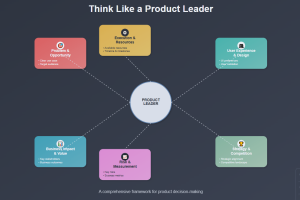
This blog represents a list of questions you can ask when thinking like a product leader. The topic includes identifying problem & opportunity, getting business impact clarity, understanding different aspects of user experience & design, success & measurement criteria, etc. If you are starting on with an exercise to solve a business problem and therefore exploring and selecting a product, you might find these questions useful.
Core Problem & Opportunity
Product leaders must first establish a crystal-clear understanding of the problem they’re solving and the opportunity it represents. This foundational work involves deeply understanding your target users, their pain points, and the real-world scenarios where your solution will add value.
- Is there a clear use case I am solving for?
- Do I know which audience or persona I am targeting?
- Do I know my user pains?
- Do I know the cost of inaction?
- Why is this crucial to your business right now?
- Is there a clear business need for your efforts? And what is it?
Stakeholder & Impact Clarity
Every product initiative must connect to tangible business outcomes that matter to your organization and its stakeholders. This means being able to articulate not just what you’re building, but why it matters in terms of revenue, cost savings, user experience improvements, or other key performance indicators. Understanding which stakeholders benefit—and how—helps prioritize features and ensures you’re solving problems that actually move the needle for your business.
- Are you clear on which key stakeholders (employees or customers) you are helping?
- Do I know which systems are in question?
- Do I know which system or content owners to work with?
- Are you able to speak about impact and business outcomes that matter – like increased revenues, lower costs, improved experience, retention, etc.
User Experience & Design
Great products are built with a deep understanding of how users actually work, think, and behave. This goes beyond surface-level preferences to understand workflows, mental models, and the context in which your product will be used. User validation should happen early and often—assumptions about user needs are often wrong, and the cost of building the wrong thing far exceeds the investment in proper user research.
- Do I know what my user UI preferences are?
- Have I validated this need directly with my target users/customers?
- What’s the desired user journey and experience?
- How does this solution fit into existing user workflows?
Success & Measurement
Product development is inherently uncertain, and great product leaders plan for that uncertainty. This means identifying potential roadblocks early, developing contingency plans, and establishing clear metrics that will signal whether you’re on the right track. Leading indicators are often more valuable than lagging metrics—they help you course-correct before small problems become big failures. Success measurement should include both quantitative metrics and qualitative feedback loops that inform continuous improvement.
- Why is this valuable & will you be able to measure success?
- What are your leading indicators (not just lagging metrics) that will signal early success or failure?
- How will you iterate and improve based on user feedback?
Strategic Alignment & Competition
Product decisions should never exist in isolation—they must align with broader company strategy and long-term vision. Understanding your competitive landscape helps you identify opportunities for differentiation and areas where you need to match market expectations. Consider not just current competitors, but emerging threats and changing market dynamics. The implications of not pursuing an opportunity can be just as important as the benefits of moving forward.
- How does this initiative align with your company’s overall strategy and long-term vision?
- What does the competitive landscape look like for this solution?
- What are the competitive implications if you don’t pursue this opportunity?
Execution & Resources
Even the best product ideas fail without proper execution planning. This involves honestly assessing available resources—not just budget and technology, but team capabilities, time constraints, and organizational capacity for change. Successful product leaders think through the entire delivery pipeline, from initial development through launch and ongoing maintenance. Clear milestones and realistic timelines help manage expectations and enable course corrections when needed.
- What processes, resources, and technologies are available to you?
- Do you have the right team and skills to execute this successfully?
- What’s your timeline and key milestones for delivery?
Risk Management
- What are the key risks and potential roadblocks, and how will you address them?
- What’s your contingency plan if initial assumptions prove incorrect?
- What dependencies could derail this initiative?
Technical & Implementation
- What technical constraints or requirements need to be considered?
- How will this integrate with existing systems and processes?
- What’s the minimum viable product (MVP) approach?
- Coefficient of Variation in Regression Modelling: Example - November 9, 2025
- Chunking Strategies for RAG with Examples - November 2, 2025
- RAG Pipeline: 6 Steps for Creating Naive RAG App - November 1, 2025
I found it very helpful. However the differences are not too understandable for me